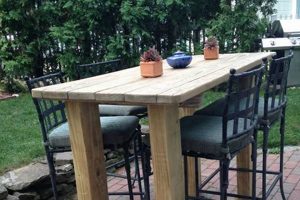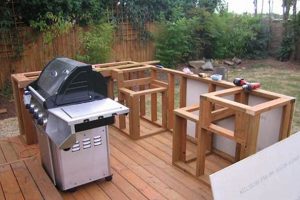A “do-it-yourself” outdoor Christmas nativity scene constitutes a decorative display depicting the birth of Jesus, constructed by individuals rather than purchased pre-made. Examples range from simple silhouettes crafted from plywood to elaborate arrangements utilizing repurposed materials, lighting, and figurines.
The creation of such displays offers a tangible expression of religious belief during the Christmas season, contributing to the festive atmosphere of neighborhoods. The practice fosters creativity, resourcefulness, and community engagement. Furthermore, it provides an opportunity to personalize a traditional symbol, reflecting individual artistic expression and budgetary constraints.
The following sections will detail specific considerations for planning, designing, constructing, and maintaining a visually appealing and structurally sound display, including material selection, safety precautions, and design tips for various skill levels and environmental conditions.
Tips for Constructing a Do-It-Yourself Outdoor Christmas Nativity
Constructing an outdoor nativity scene requires careful planning and execution to ensure both aesthetic appeal and structural integrity, particularly when creating the scene independently.
Tip 1: Prioritize Weather Resistance: Select materials capable of withstanding the expected environmental conditions, including precipitation, wind, and temperature fluctuations. Pressure-treated wood, exterior-grade paints, and weather-resistant fabrics are recommended.
Tip 2: Plan for Adequate Illumination: Implement appropriate lighting solutions to enhance visibility during nighttime hours. Consider solar-powered spotlights, low-voltage landscape lighting, or strategically placed floodlights. Ensure all electrical components are rated for outdoor use.
Tip 3: Ensure Structural Stability: Design and construct the structure to withstand potential wind loads. Utilize appropriate anchoring techniques, such as stakes or sandbags, to secure the display to the ground. Verify the stability of all figurines and components.
Tip 4: Scale Appropriately for the Location: Consider the available space when determining the size of the nativity scene. A display that is too large may overwhelm the area, while one that is too small may be easily overlooked. Take measurements to ensure proper proportions.
Tip 5: Focus on Figure Durability: Figurines should be constructed or treated to resist damage from weather and handling. Consider using resin, concrete, or weatherproofed wood. Regular inspection and maintenance are essential to prolong the lifespan of the figures.
Tip 6: Secure Electrical Wiring: Implement safety measures for all electrical wiring. Use weatherproof extension cords and connectors, and ensure all connections are elevated above ground level to prevent water damage and potential hazards. Ground Fault Circuit Interrupter (GFCI) outlets are strongly advised.
Tip 7: Incorporate Authentic Details: Research traditional nativity scenes for inspiration and incorporate historically accurate details into the design. This can enhance the authenticity and reverence of the display.
By adhering to these guidelines, individuals can create a durable, visually appealing, and structurally sound outdoor Christmas nativity scene that will endure throughout the holiday season. The following section will address common design considerations and stylistic approaches to creating an impactful display.
1. Material Selection
Material selection is a pivotal aspect of creating a durable and visually compelling “do-it-yourself” outdoor Christmas nativity scene. The chosen materials directly influence the display’s longevity, resistance to environmental factors, and overall aesthetic impact. Proper consideration is crucial for a successful and enduring project.
- Wood as a Structural Component
Wood, frequently used for framing and creating silhouettes, must be selected based on its weather resistance and structural strength. Pressure-treated lumber or naturally rot-resistant species like cedar or redwood are preferable. Incorrect wood selection can lead to warping, decay, and ultimately, the failure of the structure. An example is using untreated pine, which quickly deteriorates when exposed to moisture, necessitating frequent repairs or replacement.
- Fabric for Drapery and Clothing
Fabrics used for drapery or clothing for the figures require consideration of their resistance to fading, tearing, and water damage. Outdoor-rated canvas or synthetic fabrics are better choices than delicate materials like cotton or silk. Utilizing inappropriate fabrics can lead to premature degradation and a compromised visual appearance. A real-world example includes using cotton sheeting, which will fade, mildew, and potentially tear in outdoor conditions, requiring constant upkeep.
- Lighting Materials
Materials used for lighting, including bulbs, wiring, and connectors, must be specifically designed for outdoor use. These materials must be waterproof and resistant to temperature extremes to prevent electrical hazards and ensure reliable illumination. Using indoor-rated lighting can result in short circuits, electrical fires, and personal injury. A specific example is using standard indoor Christmas lights, which lack the necessary weather sealing and pose a significant safety risk when exposed to rain or snow.
- Figure Construction Materials
Materials for constructing the nativity figures themselves, such as resin, concrete, or metal, should be chosen for their durability and resistance to cracking, chipping, and fading. Each material offers different levels of weather resistance and requires specific handling techniques. Choosing unsuitable materials can lead to damage from frost, sunlight, or physical impact. An illustration is using unsealed plaster, which will absorb moisture, crack during freezing temperatures, and ultimately crumble, requiring the figures to be rebuilt or replaced.
Therefore, material selection is not merely a matter of aesthetics but a critical determinant of the longevity, safety, and visual impact of a “do-it-yourself” outdoor Christmas nativity. Careful planning and informed choices are essential for creating a display that endures and effectively conveys the intended message throughout the holiday season.
2. Structural Integrity
Structural integrity is paramount in the context of a “do-it-yourself” outdoor Christmas nativity scene. The outdoor environment presents numerous challenges, including wind, rain, snow, and temperature fluctuations. A nativity scene lacking sufficient structural integrity is susceptible to damage or collapse, resulting in aesthetic degradation, potential safety hazards, and the need for costly repairs or replacement. The cause-and-effect relationship is direct: inadequate design and construction lead to structural failure under environmental stress.
The importance of structural integrity manifests in several key areas. First, a stable structure ensures the nativity scene remains upright and intact throughout the Christmas season, maintaining its visual appeal and symbolic significance. Second, a structurally sound display minimizes the risk of components detaching and becoming projectiles in windy conditions, preventing property damage or personal injury. Third, proper construction techniques extend the lifespan of the nativity scene, reducing the frequency of maintenance and replacement, thereby representing a sustainable and cost-effective approach. For example, a simple plywood silhouette nativity lacking a robust support system will likely topple in moderate winds, while a heavier, more elaborate structure requires a solid foundation and well-braced elements to withstand the same conditions.
In conclusion, prioritizing structural integrity is not merely a matter of aesthetics but a fundamental requirement for creating a safe, durable, and visually impactful “do-it-yourself” outdoor Christmas nativity scene. Adhering to sound engineering principles, employing appropriate materials, and implementing robust construction techniques are essential for ensuring the nativity’s longevity and its ability to withstand the challenges of the outdoor environment. Addressing potential structural weaknesses during the design and construction phases contributes directly to the overall success and enduring value of the display.
3. Weather Resistance
The durability and longevity of any “do-it-yourself” outdoor Christmas nativity are directly contingent upon its weather resistance. The extended exposure to environmental elements including precipitation, temperature fluctuations, ultraviolet radiation, and wind necessitates careful consideration of material selection and construction techniques. Failure to adequately address weather resistance will result in premature degradation, aesthetic decline, and potential structural failure of the display. The causality is explicit: prolonged exposure to adverse weather conditions, coupled with insufficient protective measures, leads to deterioration.
The importance of weather resistance in “do-it-yourself” outdoor Christmas nativities is multifaceted. First, it preserves the visual integrity of the display, ensuring that colors remain vibrant and materials retain their original form, contributing to its aesthetic appeal. Second, it safeguards the structural integrity of the nativity scene, preventing warping, cracking, or rotting of components, thus extending its lifespan and reducing the need for frequent repairs or replacements. Third, it minimizes the risk of electrical hazards associated with outdoor lighting, safeguarding both the display and its surroundings. As an example, a nativity scene constructed using untreated wood and unprotected electrical wiring is highly vulnerable to water damage and electrical short circuits, particularly during periods of heavy rainfall or snowfall. Conversely, a nativity scene built with pressure-treated lumber, weather-resistant paints, and outdoor-rated lighting components will exhibit significantly greater resilience.
In summary, weather resistance is an indispensable component of any successful “do-it-yourself” outdoor Christmas nativity. By prioritizing material selection, employing appropriate protective coatings, and adhering to sound construction practices, individuals can significantly extend the lifespan, enhance the visual appeal, and ensure the safety of their displays. Ignoring the imperative of weather resistance not only compromises the aesthetic value of the nativity scene but also increases the likelihood of costly repairs and potential safety hazards, thereby undermining the overall purpose of creating a meaningful and enduring representation of the Christmas narrative.
4. Lighting Design
Lighting design is integral to a do-it-yourself outdoor Christmas nativity, functioning not only as a source of illumination but also as a key element in shaping the overall ambiance and visual impact of the display. The strategic application of lighting techniques can accentuate specific features, create a sense of depth, and evoke desired emotions, ultimately enhancing the narrative being conveyed.
- Highlighting Key Figures
Strategic illumination of figures such as Mary, Joseph, and the infant Jesus draws attention to the central narrative of the nativity scene. Spotlights, carefully aimed, can create a focal point, emphasizing the significance of these figures. For instance, a warm-toned spotlight directed at the manger can symbolize divine light and warmth, while subtly shadowed areas around the periphery of the scene create depth and focus the viewer’s attention.
- Creating Atmospheric Effects
Lighting can manipulate the atmosphere of the nativity scene, transforming it from a simple display into a compelling visual narrative. Diffused lighting can evoke a sense of peace and serenity, while colored gels placed over light sources can create specific moods. Blue-toned lighting might suggest a cold, starlit night, while amber hues create a warmer, more inviting atmosphere.
- Enhancing Architectural Details
Lighting can accentuate the architectural features of the stable or backdrop, adding depth and realism to the scene. Uplighting techniques can emphasize the texture of stone or wood, while strategically placed lights can create dramatic shadows, enhancing the three-dimensionality of the structure. Proper illumination prevents the structure from appearing flat or two-dimensional, contributing to a more immersive viewing experience.
- Ensuring Safety and Functionality
Beyond aesthetics, lighting plays a crucial role in ensuring the safety and functionality of the nativity scene. Well-lit pathways around the display can prevent accidents, while appropriately rated outdoor lighting fixtures minimize the risk of electrical hazards. Furthermore, strategically placed lights can deter vandalism and theft, protecting the investment and preserving the integrity of the display.
The integration of these lighting design facets into a do-it-yourself outdoor Christmas nativity transforms the display from a static representation into a dynamic and engaging narrative. By carefully considering the placement, intensity, and color of light, creators can enhance the visual impact, evoke desired emotions, and ensure the safety and longevity of their displays, contributing to a more meaningful and impactful Christmas tradition.
5. Figure Composition
Figure composition within a “diy outdoor christmas nativity” is a critical element that directly influences the narrative impact and visual coherence of the display. The arrangement, scale, and style of the figures relative to one another and the setting significantly impact the story conveyed to viewers. A poorly composed arrangement can obscure the intended message or appear disjointed, diminishing the overall effectiveness. For example, figures of disproportionate size or placed illogically within the scene disrupt the visual harmony and detract from the devotional atmosphere.
The selection of figures dictates the visual representation of key characters and, thus, impacts the interpretation of the nativity story. The choice to use stylized, minimalist figures versus realistic, detailed ones affects the emotional response of the viewer. The number of figures included and their placement relative to the central manger scene contribute to the perceived level of activity and reverence. A sparsely populated scene may evoke a sense of quiet solitude, while a crowded arrangement suggests a more communal celebration. Proper composition, therefore, necessitates a conscious selection of figures that align with the desired aesthetic and theological emphasis.
Effective figure composition in a “diy outdoor christmas nativity” requires a blend of artistic sensibility and theological awareness. Achieving a balanced and visually compelling arrangement enhances the viewer’s engagement and promotes a deeper appreciation of the Christmas story. Challenges include managing scale discrepancies when using repurposed figures and ensuring the durability of the figures in outdoor conditions. The integration of these elements underscores the importance of careful planning and execution in creating a meaningful and impactful nativity display, ultimately contributing to a more profound celebration of the Christmas season.
6. Scale Appropriateness
Scale appropriateness is a critical design consideration in the creation of a “diy outdoor christmas nativity.” The relationship between the size of the nativity scene and its surrounding environment directly impacts its visual impact and the overall aesthetic harmony of the space. The dimensions of the structure, the figures, and any accompanying elements must be proportionally consistent with the intended viewing area to ensure that the display is neither overwhelming nor underwhelming.
The importance of scale manifests in several practical ways. A nativity scene that is too large for its setting can appear cluttered and visually jarring, disrupting the tranquility often associated with the Christmas narrative. Conversely, a display that is too small may be easily overlooked, failing to capture the attention of passersby or effectively convey its intended message. For example, a life-size nativity scene in a small yard might dominate the space, while a miniature display in a sprawling landscape would likely be lost. Therefore, accurately assessing the available space and scaling the nativity scene accordingly is crucial. The absence of proper scale consideration can diminish the overall impact and detract from the meaningfulness of the display.
In summary, achieving scale appropriateness is essential for a visually compelling and contextually relevant “diy outdoor christmas nativity.” Careful planning and precise execution are necessary to ensure that the dimensions of the display are harmoniously integrated with its surroundings. Overlooking this aspect can compromise the aesthetic appeal, reduce the narrative impact, and ultimately diminish the value of the project. Therefore, individuals undertaking such projects must prioritize scale appropriateness as a fundamental design principle.
7. Artistic Interpretation
Artistic interpretation in the context of a “diy outdoor christmas nativity” refers to the individual stylistic choices and creative approaches employed in the design and construction of the display. These choices reflect the maker’s personal vision, cultural background, and theological understanding, resulting in a unique expression of the Christmas narrative.
- Material Selection as Artistic Expression
The materials chosen for the nativity’s construction extend beyond mere practicality; they represent a deliberate artistic statement. Reclaimed wood might symbolize humility and resourcefulness, while polished metal suggests reverence and elevated status. The texture, color, and origin of materials all contribute to the visual language of the piece. For example, a nativity constructed from driftwood found along a local shore connects the display to its specific geographical location, imbuing it with regional significance.
- Stylistic Representation of Figures
The figures within the nativity scene are subject to varying artistic interpretations. Some creators opt for traditional, realistic representations of Mary, Joseph, and Jesus, while others employ abstract or stylized forms. These choices reflect differing aesthetic sensibilities and theological emphases. A nativity featuring elongated, angular figures might evoke a sense of spiritual yearning, while a display with rounded, childlike forms emphasizes innocence and familial love.
- Setting and Contextual Elements
The incorporation of background elements and contextual details provides another avenue for artistic interpretation. The design of the stable, the inclusion of landscape features, and the arrangement of lighting all contribute to the overall mood and narrative of the scene. A nativity set against a backdrop of stark, winter trees might evoke a sense of isolation and contemplation, while a display surrounded by colorful lights and festive decorations suggests celebration and joy.
- Personal Symbolism and Narrative Inclusion
The integration of personal symbols and the expansion of the traditional nativity narrative represent a more overt form of artistic interpretation. Some creators incorporate family heirlooms, cultural artifacts, or contemporary elements into their displays, imbuing them with personal significance. Others expand the scene to include additional figures or events from the Bible, offering a broader and more nuanced interpretation of the Christmas story.
In essence, artistic interpretation transforms a “diy outdoor christmas nativity” from a simple representation of a historical event into a deeply personal and expressive work of art. These creative choices reflect the individual’s understanding of the Christmas narrative and allow for a diverse range of artistic expressions, each contributing to a richer and more meaningful celebration of the holiday season.
Frequently Asked Questions
The following section addresses common inquiries regarding the planning, construction, and maintenance of a do-it-yourself outdoor Christmas nativity scene. These questions aim to provide clarity on essential aspects of the project, ensuring both a safe and aesthetically pleasing display.
Question 1: What are the primary safety considerations when constructing an outdoor nativity scene?
Electrical safety is paramount. All wiring must be rated for outdoor use, and connections should be protected from moisture. Structural stability is also critical to prevent the scene from collapsing, especially in windy conditions. Securing the display with appropriate anchoring techniques is advised.
Question 2: Which materials are best suited for resisting weather damage in an outdoor nativity scene?
Pressure-treated lumber offers resistance to rot and insect damage for structural components. Exterior-grade paints and sealants provide protection against moisture and UV degradation. For figurines, consider materials like resin or concrete, known for their durability in outdoor environments.
Question 3: How can lighting be effectively used to enhance the visual impact of a nativity scene?
Strategic lighting highlights key figures and architectural details. Warm-toned spotlights directed at the manger can symbolize divinity, while diffused lighting creates a serene atmosphere. Ensure that all lighting fixtures are designed for outdoor use and properly grounded.
Question 4: What are the recommended techniques for securing figurines to prevent them from being blown over by wind?
Figurines can be anchored using stakes, weights, or adhesives. For heavier figures, consider embedding them in a concrete base or attaching them to a stable platform. Lightweight figures may require more elaborate anchoring systems.
Question 5: How can the lifespan of an outdoor nativity scene be extended?
Regular maintenance is crucial. Inspect the display for signs of damage, such as cracks, rot, or fading paint. Reapply protective coatings as needed and store the nativity scene indoors during the off-season to minimize exposure to the elements.
Question 6: What are some creative alternatives to traditional nativity scene designs?
Alternative designs might incorporate recycled materials, abstract figure representations, or culturally specific elements. The key is to maintain the core message of the nativity story while expressing individual artistic creativity. Always ensure that the chosen design remains respectful and reverent.
In summary, the creation of a successful do-it-yourself outdoor Christmas nativity scene requires careful planning, attention to detail, and a commitment to both safety and aesthetic principles. The selection of durable materials, the implementation of appropriate lighting techniques, and the adherence to sound construction practices are essential for ensuring a lasting and meaningful display.
The subsequent section delves into the ethical considerations associated with the display of outdoor nativity scenes, particularly in public spaces.
Conclusion
This exploration of the “diy outdoor christmas nativity” has illuminated the multifaceted considerations involved in its creation, ranging from material selection and structural integrity to weather resistance, lighting design, figure composition, scale appropriateness, and artistic interpretation. Each of these elements contributes to the overall success and longevity of the display, ensuring it effectively conveys its intended message while withstanding the challenges of the outdoor environment.
The construction and presentation of a “diy outdoor christmas nativity” represent a significant undertaking, requiring careful planning, resourcefulness, and a commitment to quality craftsmanship. As communities engage with this tradition, prioritizing durability, safety, and aesthetic appeal ensures the continued relevance and meaningful impact of these displays for years to come. Furthermore, thoughtful consideration of artistic and theological elements fosters a deeper appreciation for the Christmas narrative it portrays.







